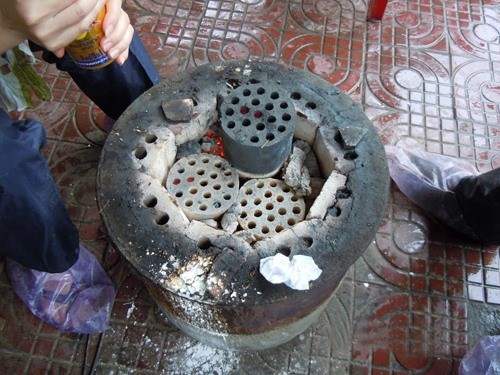Hanoi plans to stop the use of beehive-shaped coal bricks by 2020 as part of measures to improve air quality and living conditions, according to the municipal Department of Natural Resources and Environment.

Coal stoves hurt the environment (Source: petrotimes.vn)
The move was made following a recent survey by the department’s environmental office which revealed that Hanoi has about 55,000 beehive coal stoves, which burn a total of more than 528 tonnes of coal each day, filling the air with carbon dioxide.
The survey, carried out on 23 out of 30 districts and suburban districts of Hanoi last year, showed that about 63 percent of coal burners were used in urban districts, mostly by small restaurants and food shops along pavements.
Le Thanh Thuy, a representative from the department, said the use of the coal stoves was one of the key sources of environmental pollution. Other sources included a huge amount of fumes from vehicles, construction sites and the burning of rubbish.
Many people know the environmental harm of using an earthenware stove with coal, but it remains a habit for many Vietnamese. Many families in both rural and urban areas use them to overcome the rising costs of gas and electricity.
Nguyen Thi Hanh from Bach Khoa ward, Hai Ba Trung district, said she still used a stove with coal to cook, although she had a gas cooker.
“I prefer using coal stove as it is cheaper, particularly when you have to braise food like meat and fish. Besides, I have been using it for a long time and find it hard to get rid of it,” she said.
However, Le Hoai Thu, a mother of two, in Hoang Mai district, said she felt uncomfortable to see some of her neighbours still using the cookers.
“I can’t stand their smell. Inhaling carbon dioxide released from coal burners is harmful to your health, especially children. I have to close all the windows and doors of my house whenever my neighbours burn the coal,” she said.
According to experts, the use of beehive coal poses serious threats to health. They normally produce carbon dioxide, but in unventilated rooms, they start to produced deadly carbon monoxide, which is a killer.
Once inhaled, carbon monoxide molecules bind to the oxygen-carrying sites in red blood cells, cutting off the supply of oxygen to the body, especially the brain. Gradually, those exposed to the substance lose consciousness and face permanent brain damage from oxygen deprivation, if not death.
Statistics of the Poisoning Prevention Centre under the Hanoi-based Bach Mai Hospital show that dozens of patients need treatment for coal air poisoning per year, and many people die.
As part of the plan to end the use of the stoves, the environment office has chosen Ba Dinh and Hoan Kiem districts to pilot a campaign to raise public awareness while introducing new kinds of stoves using clean fuel.
The department recently singed an agreement with the SNV, a Netherlands Development Organisation, on a programme to pilot the use of environmentally friendly stoves in the capital city.
Mai Trong Thai, head of the Hanoi Environmental Protection Department, told the Kinh te và Do thi (Economic and Urban Affairs) newspaper that the city targeted to reduce 70 percent of beehive stoves this year and totally stop their use by 2020.
Under the pilot programme, citizens in Ba Dinh and Hoan Kiem districts can borrow stoves that use clean fuels to use for one month. From February to April this year, people will enjoy a discount of 30-40 percent to buy them.
The SNV organisation claims that the stoves have been "strictly tested" for exhaust levels, safety and fuel efficiency. Fuels for the stoves are said to meet international standards.-VNA